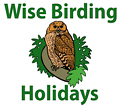

The amazing Plate-billed Mountain Toucan at Bellavista Lodge in Northern Ecuador by Dubi Shapiro.
- There are over 1600 bird species in mainland Ecuador, a country less than a quarter the size of Colombia (over 1950 species) and no bigger than Colorado; more birds per square mile than any other country in the world
- Thanks mainly to the close proximity of Andean highland temperate forests and Amazonian lowland tropical forests
- Birds which include some of South America’s and the world’s most spectacular species, not least Andean Condor, Hoatzin, macaws,
many of over 130 hummingbirds recorded in the country,
quetzals, jacamars, toucans, cotingas,
manakins and many colourful tanagers - And some of South America’s and the world’s most spectacular localized birds, notably Zigzag Heron, Oilbird and Black-necked Red-cotinga
- As well as many Choco endemics, the very wet forest region from far east Panama through western Colombia to western Ecuador which supports the largest number of restricted-range species of any Endemic Bird Area in the Americas, including such beauties as Empress Brilliant, Velvet-purple Coronet, Toucan Barbet, Plate-billed Mountain-toucan, Orange-breasted Fruiteater, Long-wattled Umbrellabird, Club-winged Manakin, Black Solitaire, Scarlet-and-white Tanager and Yellow-collared Chlorophonia
- Hence it is possible to see (not see and hear) over 400 species in ten days, 600 in two weeks and 800 in three, including well over 70 hummingbirds, 80 'antbirds' including several antpittas at 'feeding stations', 15 cotingas and a hundred 'tanagers and allies'
- And even some mammals as well, perhaps including Pygmy Marmoset, two tamarins and a few monkeys, although most, especially Spectacled Bear and Mountain Tapir, are very elusive
- The world record for the number of birds recorded in 24 hours was set in Ecuador on the 8th of October 2015 by Dušan Brinkhuizen, Rudy Gelis, Mitch Lysinger and Tuomas Seimola. The old record of 354 (see below) was broken between the lowland Amazon rain forest near Tena in the east and the Papallacta area in the Andes and yet more birds were recorded near Quito, bringing the total to 385 by dusk. The team then took a commercial flight to the Santa Elena peninsula on the Pacific coast in southern Ecuador and added many more species at roost and in their ringing nets to reach an incredible total of 425! The previous record was set in Northern Peru in October 2014 when a total of 354 species (of which just 232 were actually seen) was recorded by a team from Louisiana State University Museum of Natural Science. This total was recorded along a transect from montane forest in the Abra Patricia area down to Amazonian lowland forest near Moyobamba. The record before that, which stood for nearly 30 years, was set in Kenya in 1986 when, with the aid of a light aircraft, a total of 342 species was reached (of which an incredible 333 were seen). The best total before 1986 was set in Peru, at Cocha Cashu Biological Station in Manu National Park, Southern Peru, in 1982, and this is still arguably the most impressive, because Ted Parker and Scott Robinson recorded an incredible 331 species in a square mile!
- On a trip to Ecuador which includes the Andes and Amazonia lasting three to four weeks it is possible to record over 850 species and on the Birdquest Ultimate Ecuador tour in October 2016 an astonishing 891 species were recorded (825 of which were seen) in 25 days including 720 during the first 16 days before the Amazonia section, a list which included 77 hummingbirds, 21 nightbirds, 22 woodpeckers, 14 toucans, 18 cotingas and 107 tanagers and allies, with individual species such as Agami and Zigzag Herons, Rufous-bellied Seedsnipe, Oilbird, Black-billed and Plate-billed Mountain-toucans, Sapayoa, Rufous-crowned Pittasoma, Black-necked Red-cotinga and Scarlet-and-white Tanager! However, in neighbouring Colombia over 1000 species are possible in a month and Rockjumper have managed this on three occasions, including 2014 when they recorded an incredible 1044 species in 29 days in January-February! A list which included 63 endemics, 36 parrots, 9 owls, 11 nightjars, 86 hummingbirds, 10 trogons, 15 puffbirds, 16 toucans, 27 woodpeckers, 60 antbirds, 14 antpittas, 14 cotingas, 12 manakins and 113 tanagers and allies.
- The rare endemic Esmeraldas Woodstar occurs (mainly Jan–Apr) in Jocotoco's Rio Ayampe Reserve near the west coast of Ecuador, along with Ochre-bellied Dove, Ecuadorian Trogon, Little and Short-tailed Woodstars, Henna-hooded Foliage-gleaner and Superciliated Wren. Since 2017, Fundacion Jocotoco has released a total of 14 Great Green Macaws here, the macaws having disappeared from the region some 50 years ago as a result of loss of habitat to agriculture, ranching and illegal collection for the pet trade.
- On and around Isla de la Plata, sometimes called 'The Poor Man's Galapagos', in Machalilla National Park but 30 km/1.5 to 2 hours by boat out of Puerto Lopez off the west coast of Ecuador, it is possible to see nesting Waved Albatrosses (adults usually have small chicks by the second half of July although sometimes the nests are declared 'off-limits' to the visiting public), as well as Red-billed Tropicbirds, Magnificent Frigatebirds, and Blue-footed (displaying their feet during the second half of July) and Nazca Boobies, while landbirds include Short-tailed Woodstar, Long-tailed Mockingbird, Grey-and-white Tyrannulet, Vermilion Flycatcher and Collared Warbling-finch. Snorkelling is excellent and during the boat trips to and from the island it is possible to see Green Turtles and Humpback Whales (mostly May-Sep). In the national park on the mainland there is a chance of Southern Tamandua with Chilean Flamingos nearby.
- The only other place in the world where Waved Albatrosses nest is the Galapagos. Many tour companies include these islands in their itineraries to Northern Ecuador or offer a trip there as an extension and as well as the albatrosses and other seabirds mentioned under Machalilla there are Red-footed Boobies, Great Frigatebirds, Swallow-tailed Gulls, and over 20 endemic bird species including Galapagos Penguin, Flightless Cormorant, and several mockingbirds and finches, as well as Giant Tortoises and Marine Iguanas.
- There are many more, different, bird species in Southern Ecuador including the newly-described and highly threatened Blue-throated Hillstar, numerous other hummingbirds such as Rainbow Starfrontlet, the endemic El Oro Parakeet, Crescent-faced and Jocotoco Antpittas, Long-wattled Umbrellabird, the endemic Pale-headed Brush-finch, Giant Conebill, Tit-like Dacnis, many tanagers, not least the very localized Orange-throated Tanager, and over 40 Tumbesian endemics restricted to southern Ecuador and northern Peru including White-tailed Jay.
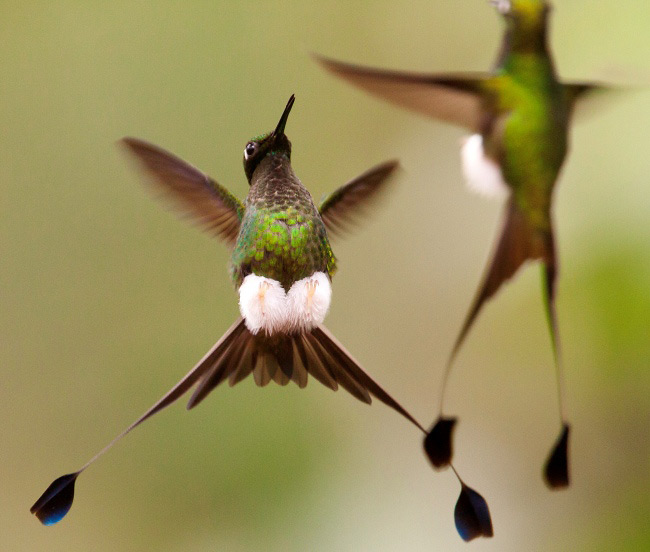
Booted Racket-tails at Tandayapa Lodge by Dubi Shapiro.
Best Birds and other wildlife in Northern Ecuador
Birds
Endemics (whole of Ecuador) 8 Northwest 1 Black-breasted Puffleg.
(Turquoise-throated Puffleg is known only from a few specimens taken in the nineteenth century)
West 2 Esmeraldas Woodstar and Lilacine (Red-lored) Amazon.
South/Southwest 5 Blue-throated Hillstar, Violet-throated Metaltail, El Oro Parakeet, Ecuadorian Tapaculo and Pale-headed Brush-finch.
Near-endemics (whole of Ecuador)
Ecuador and Colombia 100 (20 hummingbirds, five antpittas, an umbrellabird and 13 tanagers) Berlepsch’s Tinamou, Baudo Guan, Rufous-fronted Wood-quail, Dark-backed Wood-quail, Dusky Pigeon, Purple Quail-dove, Choco Poorwill, White-whiskered Hermit, Western Wedge-billed Hummingbird, Gorgeted Sunangel, Tourmaline Sunangel, Violet-tailed Sylph, Ecuadorian Hillstar, Viridian Metaltail, Hoary Puffleg, Black-thighed Puffleg, Sapphire-vented Puffleg, Golden-breasted Puffleg, Brown Inca, Velvet-purple Coronet, Rufous-gaped Hillstar, Purple-bibbed Whitetip, Pink-throated Brilliant, Empress Brilliant, Western Emerald, Purple-chested Hummingbird, Gray’s Hummingbird (Blue-headed Sapphire), Banded Ground-cuckoo, Brown Wood-rail, Cloudforest Pygmy-owl, Colombian (Rufescent) Screech-owl, Choco Trogon, Choco Toucan, Plate-billed Mountain-toucan, Orange-fronted Barbet, Five-coloured Barbet, Toucan Barbet, Lita Woodpecker, Choco Woodpecker, Plumbeous Forest-falcon, Carunculated Caracara, Rose-faced Parrot, Choco (Maroon-tailed) Parakeet, Cocha Antshrike, Stub-tailed Antbird, Esmeraldas Antbird, Rufous-crowned Pittasoma, Giant Antpitta, Moustached Antpitta, Bicoloured Antpitta, Yellow-breasted Antpitta, Crescent-faced Antpitta, Narino Tapaculo, Spillmann’s Tapaculo, Pacific Tuftedcheek, Stout-billed Cinclodes, Uniform Treehunter, Fulvous-dotted Treerunner, Club-winged Manakin, Yellow-headed Manakin, Orange-breasted Fruiteater, Chestnut-bellied Cotinga (likely to occur in north Peru), Long-wattled Umbrellabird, Pacific Flatbill, Northern Ornate Flycatcher, Choco Tyrannulet, Coopmans’s Elaenia, Plain-capped Ground-tyrant, Black-billed Peppershrike, Pale-legged (Slaty-capped) Shrike-vireo, Choco Vireo, Beautiful Jay, Quindio (Black-collared) Jay, Black Solitaire, Chestnut-throated (Rufous-brown) Solitaire, Tanager Finch, Dusky Bush-tanager, Choco (Tricoloured) Brush-finch, White-rimmed Brush-finch, Olive-crowned Yellowthroat, Choco (Golden-bellied) Warbler, Ochre-breasted Tanager, Scarlet-and-white Tanager, Scarlet-breasted Dacnis, Yellow-tufted (Black-faced) Dacnis, Black-winged Saltator, Western Black-eared Hemispingus, Stolzmann’s Tanager (Black-backed Bush Tanager), Ochraceous (Cinereous) Conebill, Indigo Flowerpiercer, Purplish-mantled Tanager, Black-chinned Mountain-tanager, Glistening-green Tanager, Yellow-green Tanager (Chlorospingus), Moss-backed Tanager, Golden-chested Tanager, Rufous-throated Tanager, Scrub Tanager, Yellow-faced (Flame-faced) Tanager and Blue-whiskered Tanager.
Ecuador, Colombia and Peru 38 Pallid Dove, Ecuadorian Piedtail, Rainbow-bearded Thornbill, Buff-winged Starfrontlet, Chestnut-breasted Coronet, Green-backed (White-tailed) Hillstar, Rufous-vented Whitetip, Cinnamon Screech-owl, Coppery-chested Jacamar, Brown Nunlet, Guayaquil Woodpecker, Scarlet-backed Woodpecker, Pacific Parrotlet, Yasuni Stipplethroat (Antwren), Chestnut-naped Antpitta, White-bellied Antpitta, Western Tawny Antpitta, Long-tailed Tapaculo, Paramo Tapaculo, Pacific Hornero, Spectacled Prickletail, Grey-tailed Piha, Dusky Piha, Foothill Schiffornis, Ecuadorian Tyrannulet, Orange-eyed Flatbill (Flycatcher), Ochraceous Attila, Snowy-throated Kingbird, Mouse-grey (Bran-coloured) Flycatcher, Turquoise Jay, Plain-tailed Wren, Orange-crowned Euphonia, Ecuadorian Cacique, Scrub Blackbird, Ecuadorian (Blue) Seedeater, Masked Saltator, Masked Mountain-tanager and Golden-naped Tanager.
Ecuador and Peru 108 (13 hummingbirds, three antpittas and 17 tyrant flycatchers) Pale-browed Tinamou, Peruvian Pigeon, Ochre-bellied Dove, Ecuadorian Ground-dove, Scrub Nightjar, Porculla (Grey-chinned) Hermit, Ecuadorian (Long-billed) Hermit, Little Sunangel, Purple-throated Sunangel, Royal Sunangel, Green-headed Hillstar, Neblina Metaltail, Rainbow Starfrontlet, Peruvian (Booted) Racket-tail, Tumbes Hummingbird, Amazilia Hummingbird, Short-tailed Woodstar, Purple-collared Woodstar, Imperial Snipe, Peruvian Screech-owl, Grey-backed Hawk, Ecuadorian Trogon, Black-billed (Emerald) Toucanet, Pale-billed (Collared) Aracari, Ecuadorian Piculet, Northern Andean Flicker, Dusky-winged (Lineated) Woodpecker, Grey-cheeked Parakeet, Red-faced Parrot, Wavy-breasted (Rose-fronted) Parakeet, White-necked Parakeet, Cordilleran (Scarlet-fronted) Parakeet, Red-masked Parakeet, Ancient Antwren, Chapman’s Antshrike, Collared Antshrike, Lunulated Antbird, Grey-headed Antbird, Maranon Crescentchest, Elegant Crescentchest, Watkins’s Antpitta, Jocotoco Antpitta, Peruvian Antpitta, Chusquea Tapaculo, Rufous-necked Foliage-gleaner, Henna-hooded Foliage-gleaner, Mouse-coloured Thistletail, Equatorial Greytail, Line-cheeked Spinetail, Maranon Spinetail, Blackish-headed Spinetail, Necklaced Spinetail, Jet Manakin, Scaly-breasted (Scarlet-breasted) Fruiteater, Pacific Royal Flycatcher, Slaty Becard, Cinnamon-breasted Tody-tyrant, Orange-banded Flycatcher, Loja Tyrannulet, Tawny-fronted (Tawny-crowned) Pygmy-tyrant, Pacific Elaenia, Tumbes (Mouse-coloured) Tyrannulet, Grey-and-white Tyrannulet, Rufous-winged Tyrannulet, Black-crested Tit-tyrant, Baird’s Flycatcher, Sooty-crowned Flycatcher, Olive-chested Flycatcher, Jelski’s Chat-tyrant, Tumbes Tyrant, Andean (Jelski’s) Black-tyrant, Grey-breasted Flycatcher, Western Tropical Pewee, Olivaceous Greenlet, White-tailed Jay, Chestnut-collared Swallow, Tumbes Swallow, Fasciated Wren, Speckle-breasted Wren, Maranon Wren, Bar-winged Wood-wren, Long-tailed Mockingbird, Ecuadorian Thrush, Plumbeous-backed Thrush, Maranon Thrush, Saffron Siskin, Tumbes Sparrow, Black-capped Sparrow, Maranon (Black-capped) Sparrow, White-winged Brush-finch, Cream-crowned (White-winged) Brush-finch, White-headed Brush-finch, Bay-crowned Brush-finch, White-edged Oriole, Pale-eyed Blackbird, Black-lored (Masked) Yellowthroat, Grey-and-gold Warbler, Three-banded Warbler, Black-cowled Saltator, Crimson-breasted Finch, Parrot-billed Seedeater, Drab Seedeater, Collared Warbling-finch, Piura (Black-eared) Hemispingus, Buff-bellied Tanager, Sulphur-throated Finch, Streaked (Tit-like) Dacnis and Orange-throated Tanager.
Ecuador, Peru and Brazil 1 Orange-crested Manakin.
Ecuador, Peru and Bolivia 6 Rufous-breasted (Leymebamba) Antpitta, White-bellied Pygmy-tyrant, Red-billed Tyrannulet, Black-and-white Tanager, Silver-backed Tanager and Straw-backed Tanager.
Ecuador, Peru and Chile 6 Peruvian Thick-knee, Grey Gull, Belcher’s Gull, Peruvian Tern, Peruvian Pygmy-owl and Short-tailed Field-tyrant.
Other specialities
Zigzag Heron, Carunculated Caracara, Imperial Snipe, Rufous-bellied Seedsnipe (endemic latreillii race), and Andean, Long-tailed and Rufous
Potoos.
Others
Torrent Duck, guans, Black-faced Ibis, Andean Condor, Black-chested Buzzard-eagle, Hoatzin, Andean Lapwing, Pied Plover, Andean Gull, pigeons, doves,
parakeets, parrots, Blue-and-yellow and Scarlet Macaws, owls including Crested, numerous hummingbirds (many at feeders) including Sword-billed, all five
South American kingfishers, motmots, jacamars including Great, White-eared and Yellow-billed, trogons, quetzals, puffbirds, White-faced Nunbird, barbets,
aracaris, toucans, toucanets, woodpeckers, foliage-gleaners, spinetails, Pearled Treerunner, Streaked Tuftedcheek, woodcreepers, antshrikes, antwrens,
antbirds, Ringed Antpipit, tapaculos including Ocellated, tyrant flycatchers, Golden-winged, Spotted and Yellow-browed Tody-flycatchers, Andean
Cock-of-the-rock (red sanguinolenta race at leks), Amazonian Umbrellabird, Dusky, Olivaceous and Screaming Pihas, Bare-necked and Purple-throated
Fruitcrows, Wing-barred Piprites, becards, tityras, Slaty-capped Shrike-vireo, Black-capped Donacobius, White-capped Dipper, wintering warblers,
Slate-throated and Spectacled Redstarts, conebills, bush tanagers, hemispinguses, mountain and numerous other tanagers including Flame-faced, Golden,
Golden-eared, Grass-green, Orange-eared and Paradise, Fulvous Shrike-tanager, dacnises, honeycreepers, Plushcap, flowerpiercers, brush-finches, Red-capped
Cardinal, Oriole Blackbird, caciques, oropendolas and euphonias.
Mammals
Pygmy Marmoset, Black-mantled and Golden-mantled Tamarins, Colombian Howler, White-fronted Capuchin, Noisy (Spix's)
Night, Equatorial Saki, Black-headed Spider (rare in Choco), White-bellied Spider, Common Squirrel, Lucifer (Yellow-handed) Titi, Red-bellied Titi and
Silvery Woolly Monkeys, Black and Central American Agoutis, Olinguito, Andean White-eared Opossum, Tayra and Kinkajou. Also a chance of Spectacled Bear
(mostly in August-early September), Mountain Tapir, Giant and Neotropical River Otters, and Hoffmann's Two-toed and (Brown-throated) Three-toed Sloths.
Plants
One of the richest floras on Earth includes over 3700 species of orchid - the Andes of Ecuador support the
highest diversity of orchids in the world. Also present in great diversity are arums, bromeliads, fuchsias and heliconias. Yasuni National Park in
which the Napo Wildlife Center is situated has the highest documented tree diversity in the world.
Other Natural Wonders in Northern Ecuador
Cotopaxi
This almost perfectly symmetrical volcanic cone is the highest active volcano in the world. It is largely
covered by permanent fields of ice and snow, and rises to 5897 m (19,348 ft), much higher than the neighbouring Andean peaks.
Best Sites for Birds and other wildlife in Northern Ecuador
- Andes Northwest of Quito (Quito to Playa de Oro)
- Laguna San Pablo Ecuadorian (Virginia) Rail and Subtropical Doradito.
- Alto Tambo Rose-faced Parrot, Choco Woodpecker, Stub-tailed Antbird, Choco Tapaculo, White-ringed Flycatcher, Emerald, Golden-chested, Rufous-winged and Scarlet-and-white Tanagers, and Yellow-green Bush-tanager.
- Chical Road Fulvous-dotted (Star-chested) Treerunner and Purplish-mantled Tanager, as well as Choco Parakeet, Velvet-purple Coronet, White-tailed Hillstar, Hoary Puffleg, Toucan Barbet, Plate-billed Mountain-toucan, Beautiful Jay, Black Solitaire, Black-chinned Mountain-tanager, Glistening-green, Rufous-crested and Saffron-crowned Tanagers, Plushcap and Ruddy-breasted Seedeater.
- Awa Road, near Alto Tambo Black-tipped Cotinga and Golden-chested Tanager, as well as Bronze-winged Parrot, Orange-fronted Barbet, Stripe-billed Aracari, and Choco and Yellow-throated Toucans.
- Tundaloma area Lilacine (Red-lored) and Rose-faced Parrots, White-tailed Trogon, Black-breasted and Lesser Pied Puffbirds, Five-coloured Barbet, and Scarlet-breasted and Yellow-tufted Dacnises.
- Lita area Tooth-billed Hummingbird, Choco Trogon, Choco Toucan, Choco, Crimson-bellied and Lita Woodpeckers, Black-headed Antthrush, Choco Tapaculo, Slaty-capped Shrike-vireo, Emerald, Golden-chested, Grey-and-gold, Scarlet-and-white and Scarlet-browed Tanagers.
- San Lorenzo area A chance of Brown Wood-rail, Slaty-tailed Trogon, Black-breasted Puffbird, Five-coloured Barbet, Black-tipped Cotinga and Scarlet-breasted Dacnis, and an outside chance of Blue Cotinga.
- Playa de Oro (the second wettest place on Earth after Cherrapunji in India, reached by boat from Selva Alegre) Choco Poorwill, Sapayoa, Five-coloured Barbet, Lita Woodpecker, Stub-tailed Antbird, Long-wattled Umbrellabird, Dagua (White-throated) Thrush, Tawny-crowned Greenlet, Blue-whiskered, Grey-and-gold, Rufous-winged, Scarlet-and-white and Scarlet-browed Tanagers, as well as Baudo Guan, Plumbeous Hawk, Great Green Macaw, Rose-faced Parrot, Bronze-tailed Plumeleteer, Tooth-billed Hummingbird, Choco Trogon, White-whiskered Puffbird, Choco, Guayaquil and Splendid Woodpeckers, Western (Striped) Woodhaunter, Checker-throated, Griscom’s (Moustached) and White-flanked Antwrens, Spot-crowned Antvireo, Bicoloured, Ocellated, Spotted and Zeledon’s Antbirds, Streak-chested Antpitta, Tawny-faced Gnatwren, Pacific Flatbill, Brown-capped Tyrannulet, Choco Sirystes, Black-tipped Cotinga, Rufous Piha, Choco (Green) and Red-capped Manakins, Slate-throated Gnatcatcher, Song and Stripe-throated Wrens, White-breasted Wood-wren (inornata), Scarlet-breasted and Scarlet-thighed Dacnises, Blue-whiskered, Lemon-spectacled, Scarlet-browed and Tawny-crested Tanagers, and Colombian Howler Monkey. Also a chance of Berlepsch’s Tinamou, Uniform Crake, Choco (Vermiculated) Screech-owl, Lanceolated Monklet and Rufous-crowned Gnat/Antpitta/soma.
- Playa las Penas (including Majagual, where possibly the tallest mangroves in the world grow, some of which reach over 60 m in height) Pinnated Bittern, Magnificent Frigatebird, Pacific Parrotlet, Lilacine (Red-lored) Parrot, Slaty-tailed Trogon, Jet Antbird, Panama Flycatcher, Ochraceous Attila and Peruvian Meadowlark. Also a chance of Masked Duck and Humboldt’s Sapphire.
- Andes West of Quito (Quito to Mashpi)
- El Chontal Oilbird.
- Amagusa Reserve Green Thorntail, Purple-throated Woodstar, Velvet-purple Coronet, Violet-tailed Sylph, Empress Brilliant, Brown Inca, White-whiskered Hermit, Purple-bibbed Whitetip, Toucan Barbet, Crimson-rumped Toucanet, Pacific (Buffy) Tuftedcheek, Rufous-rumped Antwren, Esmeraldas Antbird, Orange-breasted Fruiteater, Choco Warbler, Indigo Flowerpiercer, Black-chinned Mountain-tanager, Glistening-green, Lemon-rumped and Moss-backed Tanagers, and Golden-collared Honeycreeper (most of these birds can be seen at feeders).
- Mashpi, including Mashpi Shungo Chocolate Farm and entrance road to Mashpi Lodge (600 m to 1400 m) (Well over 100 species possible in a day) Rose-faced Parrot, Cloud Forest Pygmy-owl, Velvet-purple Coronet, Violet-tailed Sylph, Brown Inca, Purple-bibbed Whitetip, Empress Brilliant, Barred Puffbird, Orange-fronted, Red-headed and Toucan Barbets, Scarlet-backed Woodpecker (Mashpi Shungo), Pacific (Buffy) Tuftedcheek, Uniform Treehunter, Rufous-rumped Antwren, Esmeraldas Antbird, Narino Tapaculo, Orange-breasted Fruiteater, Club-winged (lek) and Golden-winged Manakins, Black Solitaire, Slaty-capped Shrike-vireo, Indigo Flowerpiercer, Black-chinned Mountain-tanager, Glistening-green, Grey-and-gold, Moss-backed, Ochre-breasted and Scarlet-browed Tanagers, and Yellow-collared Chlorophonia. Also a chance of Rufous-crowned Gnat/Antpitta/soma (coming to chopped earthworms at Mashpi Shungo Chocolate Farm in late 2010s), Long-wattled Umbrellabird, Black-tipped Cotinga, Choco Vireo, Silver-throated Tanager and Yellow-green Bush-tanager.
- Andes West of Quito (Quito to Tandayapa Valley and Rio Silanche)
- Yanacocha Reserve (Volcan Pichincha) (3400 m) Purple-backed Thornbill, Sword-billed Hummingbird, Golden-breasted and Sapphire-vented Pufflegs, Crimson-mantled Woodpecker, Undulated Antpitta, Ocellated Tapaculo, Barred Fruiteater, Black-chested Mountain-tanager, Golden-crowned and Grass-green Tanagers, and Blue-backed Conebill. Also a chance of Imperial Snipe, and an outside chance of Black-breasted Puffleg (mostly May-Sep) and and Grey-browed (Stripe-headed) Brush-finch.
- Maquipucuna Lodge and area Torrent Duck, Rufous Motmot, Lanceolated Monklet and Esmeraldas Antbird. Also a chance of Mottled Owl, Club-winged Manakin and Spectacled Bear if Aguacatillo is in fruit (usually around late August-early September).
- Las Gralarias, Mindo Valley Colombian Screech-owl, Gorgeted Sunangel, Buff-tailed Coronet, Violet-tailed Sylph, Golden-headed Quetzal, Toucan Barbet, Orange-breasted Fruiteater, Olivaceous Piha and Black-chinned Mountain-tanager. Also a chance of Hoary Puffleg at 'Birdwatchers House'.
- Tandayapa Valley Many lodges, private reserves, trails and hummingbird feeding stations not least Pacha Quindi (Hummingbird Place in the native language of Quichua) where a world record 40+ hummingbird species have been recorded and 10,000 people visited between 2011 and 2018! Hummingbirds in the valley include Western (Blue-tailed) Emerald (Tandayapa Lodge), Gorgeted Sunangel, Violet-tailed Sylph, Velvet-purple Coronet, Empress Brilliant, Purple-throated Woodstar, Rufous-gaped (White-tailed) Hillstar and Brown Inca, while other birds include Toucan Barbet, Plate-billed Mountain-toucan, Crimson-mantled Woodpecker, Ocellated Tapaculo (Bellavista Lodge), Beautiful Jay, Plain-tailed Wren (Bellavista), Blue-winged Mountain-tanager, many other tanagers including Grass-green, Metallic-green and Rufous-chested, Tanager Finch (Bellavista) and Plushcap. Also a chance of Black-and-chestnut Eagle, White-throated Quail-dove, Colombian Screech-owl, Lyre-tailed Nightjar, White-faced Nunbird, Scaled Antpitta. Mammals include Olinguito and Andean White-eared Opossum (both at Bellavista Lodge feeders), and there is also a chance of Tayra.
- Refugio Paz de las Aves A very popular site, visited by over 2000 birders in 2014, mainly because the owner Angel Paz ('Peace') calls in and feeds worms to up to five species species of antpitta a day; Chestnut-crowned, Giant, Moustached, Ochre-breasted and Yellow-breasted, along with Rufous-breasted Antthrush. Also present in his grounds are Violet-tailed Sylph, Empress Brilliant, Velvet-purple Coronet, Western Emerald, Golden-headed Quetzal, Red-headed and Toucan Barbets, Crimson-rumped Toucanet, Plate-billed Mountain-toucan, Narino Tapaculo, Andean Cock-of-the-rock (lek, viewable from a hide), Orange-breasted Fruiteater, Olivaceous Piha, Golden-winged Manakin and Black-chinned Mountain-tanager. Also a chance of Dark-backed Wood-quail, Lyre-tailed Nightjar and Scaled Fruiteater.
- Sachatamia Lodge Green-fronted Lancebill, Violet-tailed Sylph, Velvet-purple Coronet, Rufous-breasted Antthrush, Slate-throated Gnatcatcher and Black-chinned Mountain-tanager. Also a chance of Black-and-white Owl and Long-wattled Umbrellabird (mostly Aug-Dec).
- Recinto 23 De Junio (a village) Long-wattled Umbrellabird (most likely at dawn).
- Milpe area including Mindo Cloudforest Foundation (MCF) Reserve Club-winged Manakin (lek), as well as Choco Trogon, Crimson-rumped Toucanet, Chestnut-mandibled and Choco Toucans, Pacific Flatbill, (Western) White-throated Spadebill, Golden-winged Manakin, Choco Warbler, and Moss-backed, Ochre-breasted and Rufous-throated Tanagers. Also a chance of Yellow-tufted Dacnis and Yellow-collared Chlorophonia.
- Rio Silanche MCF Reserve (with 15 metre high canopy tower) Berlepsch's Tinamou, as well as Pallid Dove, Blue-chested and Purple-chested Hummingbirds, Purple-crowned Fairy, Barred Puffbird, Orange-fronted and Red-headed Barbets, Choco Toucan, Cinnamon Woodpecker, Dot-winged and Moustached Antwrens, Stub-tailed Antbird, Brown-capped and Choco Tyrannulets, Purple-throated Fruitcrow, Tawny-faced Gnatwren, Blue-whiskered, Grey-and-gold, Rufous-winged, Scarlet-browed and Tawny-crested Tanagers, and Scarlet-breasted, Scarlet-thighed and Yellow-tufted Dacnises. Also a chance of Rufous-fronted Wood-quail and Lanceolated Monklet.
- Rio Canande Reserve (Choco Lodge) Sapayoa and Black-headed Spider Monkey, as well as Rose-faced Parrot, Choco Screech-owl, Purple-chested Hummingbird, White-whiskered Hermit, Tooth-billed Hummingbird, Purple-crowned Fairy, Red-headed Barbet, Chestnut-mandibled and Choco Toucans, Guayaquil and Lita Woodpeckers, Slaty Spinetail, Bicoloured, Ocellated and Spotted Antbirds, Black-headed Antthrush, Spot-crowned Antvireo, Streak-chested Antpitta, Tawny-faced Gnatwren, Choco Tapaculo, Pacific Flatbill, Rufous Mourner, Black-tipped Cotinga, Rufous Piha, Blue-crowned, Choco (Green) and Red-capped Manakins, Tawny-crowned Greenlet, Scarlet-breasted, Scarlet-thighed and Yellow-tufted Dacnises, and Blue-whiskered, Emerald, Rufous-winged, Scarlet-and-white, Scarlet-browed and Tawny-crested Tanagers. Also a chance of Berlepsch’s Tinamou, Rufous-fronted Wood-quail, Tawny-faced Quail, Baudo Guan, Rufous-crowned Gnat/Antpitta/soma and Golden-chested Tanager, and an outside chance of Great Curassow, Harpy Eagle, Banded Ground-cuckoo, Indigo-crowned Quail-dove and Chocoan Bushmaster (the largest venomous snake in the world and very dangerous).
- Rio Palenque Biological Station Rufous-headed Chachalaca, Ecuadorian Ground-dove, Violet-bellied Hummingbird, Ecuadorian Trogon, Orange-fronted Barbet, Grey-breasted Flycatcher, Stripe-throated Wren, Grey-and-gold Warbler and Crimson-breasted Finch.
- Andes North of Quito
- Urcuqui area A chance of Buff-fronted Owl.
- Cerro Mongus Crescent-faced Antpitta and Chestnut-bellied Cotinga, as well as Rainbow-bearded Thornbill, Rufous and Western Tawny-bellied Antpittas, White-throated Tyrannulet, Black-breasted and Masked Mountain-tanagers, and Golden-crowned and Stolzmann's (Black-backed Bush) Tanagers.
- Andes East of Quito
- Papallacta Pass and Radio Station at 4300 m Rufous-bellied Seedsnipe (near Radio Station), Ecuadorian Hillstar, Blue-mantled Thornbill, Rainbow-bearded Thornbill, Rufous and Tawny Antpittas, Agile Tit-tyrant, Stolzmann's (Black-backed Bush) Tanager (both above Termas de Papallacta Hotel), and Pale-naped Brush-finch. Also a chance of Rufous-rumped Bush-tyrant and Masked Mountain-tanager (at treeline), and an outside chance of Giant Conebill.
- Cayembe-Coca NP A chance of Spectacled Bear and Mountain Tapir. Also an outside chance of Colocolo (Pampas/Pantanal Cat) and Stump-tailed Porcupine.
- Guango Lodge Area Torrent Duck, Grey-breasted Mountain-toucan and hummingbirds including Long-tailed Sylph, Tyrian Metaltail, Buff-winged Starfrontlet, White-bellied Woodstar, Buff-tailed and Chestnut-breasted Coronets, Tourmaline Sunangel, Glowing Puffleg and Sword-billed, Dusky Piha and Chestnut-breasted Chlorophonia. Also a chance of Mountain Avocetbill.
- Antisana NP (3800 m) Andean Condor, Black-chested Buzzard-eagle, Carunculated Caracara, Aplomado Falcon, Black-faced Ibis, Andean Lapwing, Andean Gull, Shining Sunbeam, Ecuadorian Hillstar, Giant Hummingbird, Ecuadorian Hillstar, Black-tailed Trainbearer, Stout-billed Cinclodes, Paramo Ground-tyrant and Black-billed Shrike-tyrant.
- Cabanas San Isidro-Guacamayos Ridge Area Andean Potoo, Rufous-bellied Nighthawk, Black-banded 'San Isidro' Owl, White-chested Swift, hummingbirds such as Long-tailed Sylph, Chestnut-breasted Coronet, Bronzy Inca and Emerald-bellied Puffleg, Black-billed Mountain-toucan, Crested and Golden-headed Quetzals, White-bellied Antpitta, Rufous-crowned Tody-flycatcher, Dusky Piha, Rufous-crested Tanager, Chestnut-breasted Chlorophonia and Golden-collared Honeycreeper. Also a chance of Wattled Guan, Rufous-banded Owl, Oilbird, Ash-coloured and Slate-crowned Antpittas, Barred Antthrush, Black-chested Fruiteater and White-capped Tanager, as well as Mountain Tapir (at salt lick).
- Gareno Lodge Area Rufous Potoo, Fiery Topaz, Black-eared Fairy, Brown, Great and Purplish Jacamars, Fulvous Antshrike, Thrush-like Antpitta, Golden-winged Tody-flycatcher, Dusky-chested Flycatcher and Lawrence's Thrush. Also a chance of Harpy Eagle, Pavonine Quetzal, Lanceolated Monklet and Purple-throated Cotinga.
- Wildsumaco A bird list of over 450 species including Buckley's Forest-falcon, Many-spotted Hummingbird, Napo Sabrewing, Black-throated Brilliant, Wire-crested Thorntail, Gorgeted Woodstar, Gould’s Jewelfront, Ecuadorian Piedtail, Rufous-vented Whitetip, Coppery-chested Jacamar, Chestnut-tipped and Golden-collared Toucanets, Ochre-breasted and Plain-backed Antpittas (at feeding stations with Short-tailed Antthrush), White-streaked Antvireo, Plain-winged and Yellow-breasted Antwrens, White-backed Fire-eye, Foothill Elaenia, Ecuadorian Tyrannulet, Golden-winged Tody-flycatcher, Buff-throated Tody-tyrant, Musician and Wing-banded Wrens, Chestnut-crowned Gnateater, Scarlet-breasted Fruiteater, Grey-tailed Piha, Blue-rumped and Western Striped Manakins, Wing-barred Piprites, Olivaceous Greenlet, many tanagers including Golden-eared and Orange-eared, Golden-collared Honeycreeper and Black-mantled Tamarin. Also a chance of Rufous-breasted Wood-quail, Sunbittern, Military Macaw, Band-bellied Owl, Spangled Coquette, Fiery-throated Fruiteater (Mushullacta Community Reserve on the Loreto Road) and Blue-browed Tanager.
- Rio Napo, Amazonia
- Sacha Lodge Area A 275 m (900 ft) long canopy walkway at 30 m (100 ft) with three canopy observation towers, a 43 m (140 ft) canopy observation tower, two parrot licks and a bird list of about 586 species including Great and White-eared Jacamars, Chestnut-belted Gnateater, Plum-throated, Purple-throated and Spangled Cotingas, Bare-necked and Purple-throated Fruitcrows, Screaming Piha, Wire-tailed Manakin, Musician Wren and Paradise Tanager. Also many mammals including Pygmy Marmoset, Black-mantled and Golden-mantled (south side of the river) Tamarins, and White-fronted Capuchin, Red Howler, Spix's Night, Equatorial Saki, Common Squirrel, White-bellied Spider, Lucifer Titi and Red-bellied Titi (south side of the river) Monkeys. Also a chance of Agami Heron, Sunbittern, White-plumed Antbird, Amazonian Umbrellabird, Lanceolated Monklet, White-browed Purpletuft, Orange-crested Manakin and Silvery Woolly Monkey.
- La Selva Jungle Lodge Area A 30 m (100 ft) canopy observation tower, parrot licks and a bird list of about 550 species including Zigzag Heron, Blue-and-yellow Macaw, Scarlet-shouldered Parrotlet, Long-tailed Potoo, White-chinned and White-eared Jacamars, Cocha Antshrike, Banded Antbird, Chestnut-belted Gnateater, Lesser Wagtail Tyrant, Spotted Tody Flycatcher, Plum-throated, Purple-throated and Spangled Cotingas, Bare-necked and Purple-throated Fruitcrows, Screaming Piha, Orange-crested and Wire-tailed Manakins, Paradise Tanager and Oriole Blackbird. Also a chance of Agami Heron, Sunbittern, White-plumed Antbird, Amazonian Umbrellabird, White-browed Purpletuft, Bicoloured Conebill, Black-mantled Tamarin, and Red Howler and Common Squirrel Monkeys.
- Napo Wildlife Center Area A 40 m (130 ft) canopy observation tower, parrot licks and a bird list of about 565 species including Zigzag Heron, Bicoloured Hawk, Hoatzin, Blue-and-yellow and Scarlet Macaws, Scarlet-shouldered Parrotlet, Chestnut-capped and Collared Puffbirds, aracaris, toucans, Great, White-chinned, White-eared and Yellow-billed Jacamars, antbirds including Banded and Dot-backed, Ringed Antpipit, Yellow-browed Tody-flycatcher, Bare-necked Fruitcrow and Black-necked Red-cotinga (lek along Tiputini Trail farther in Yasuni NP), White-browed Purpletuft, Blue-backed and Wire-tailed Manakins, Paradise Tanager. Also many mammals including Pygmy Marmoset, Golden-mantled Tamarin, and White-fronted Capuchin, Red Howler, Spix's Night, Common Squirrel and Red-bellied Titi Monkeys. Also a chance of Agami Heron, Salvin's Curassow, Harpy Eagle, Grey-winged Trumpeter, Sungrebe, Black-banded Owl, Hairy-crested and White-plumed Antbirds, Ash-throated Gnateater, Lanceolated Monklet, Amazonian Umbrellabird, Purple-throated Cotinga, Orange-crested Manakin, Giant and Neotropical River Otters, Hoffmann's Two-toed and (Brown-throated) Three-toed Sloths, and Kinkajou.
- Sani Lodge Area including Yasuni NP on opposite side of river A 30 m (100 ft) canopy observation tower, Zigzag Heron, Buckley's Forest-falcon, Blue-and-yellow Macaw, Hoatzin, Tawny-bellied Screech-owl, Crested Owl, Purplish, White-chinned and White-eared Jacamars, Black-bellied Thorntail, Chestnut-capped and Collared Puffbirds, Brown Nunlet, Ivory-billed Aracari, Golden-collared Toucanet, White-chinned Woodcreeper, Banded, Lunulated, Sooty and White-chested Antbirds, Cocha and Fulvous Antshrikes, Ornate and Yasuni Antwrens, Black-spotted and Reddish-winged Bare-eyes, Thrush-like Antpitta, Rusty-belted Tapaculo, Ash-throated and Chestnut-belted Gnateaters, Spotted and Yellow-browed Tody-flycatchers, Plum-throated and Spangled Cotingas, Bare-necked Fruitcrow, Amazonian Umbrellabird, White-browed Purpletuft, Orange-crested and Wire-tailed Manakins, Wing-barred Piprites, Lawrence's Thrush, Paradise Tanager and Bicoloured Conebill. Also a chance of Nocturnal and Salvin's Curassows, Agami Heron, Harpy Eagle, Grey-winged Trumpeter, Black-banded and Chestnut-headed Crakes, Sapphire Quail-dove, Long-tailed Potoo, Lanceolated Monklet, Black Bushbird, Hairy-crested, White-plumed Antbirds, White-lored Antpitta, Black-necked Red-cotinga (at lek), Purple-throated Cotinga and Ecuadorian Cacique, and an outside chance of Wing-banded Antbird and Ochre-striped Antpitta far into Yasuni NP.
- Yuturi Biological Reserve Black-necked Red-cotinga (lek), Plum-throated Cotinga, Bare-necked Fruitcrow, Wire-tailed Manakin and Musician Wren. Also a chance of White-plumed Antbird.
- Rio Shiripuno, Yasuni Biosphere Reserve/NP, Amazonia
- Shiripuno Lodge A bird list of 450 species within walking distance of the lodge, including Fiery Topaz, Black-necked Red-cotinga, Bare-necked Fruitcrow and Wire-tailed Manakin, species shared with lodges along the Rio Napo but Shiripuno is particularly good for Rufous Potoo, Collared and Spotted Puffbirds, Ocellated Woodcreeper, Hairy-crested, Lunulated, White-plumed, Wing-banded and Yellow-browed Antbirds, Yasuni Antwren, Black Bushbird and macaws. Also a chance of Nocturnal and Salvin's Curassows, Grey-winged Trumpeter, Ash-throated Gnateater, and Noisy Night, Northern Woolly and White-bellied Spider Monkeys.
- The best website for trip reports is CloudBirders
- but these are also worth a look
- Birdtours
- Fatbirder
- Jon Hornbuckle
- Mammal Watching
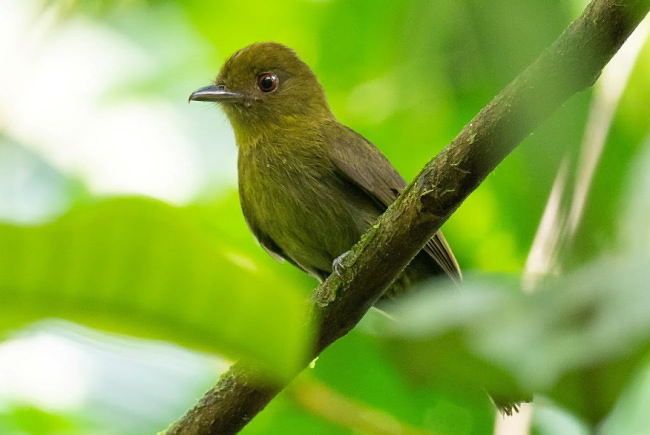
The unique Sapayoa, in a bird family of its own, at Playa de Oro, by Simon Colenutt.
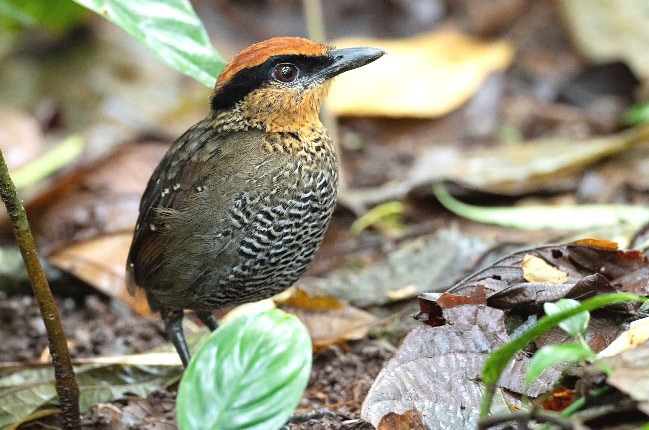
The rare Rufous-crowned Gnat/Antpitta/soma, currently considered by most taxonomists to be a member of the gnateater family not an antpitta, at Mashpi Shungo by Simon Colenutt.
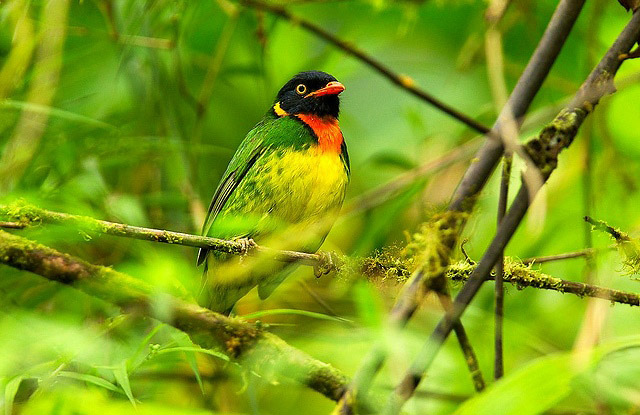
A male Orange-breasted Fruiteater at Mindo by Francesco Veronesi.
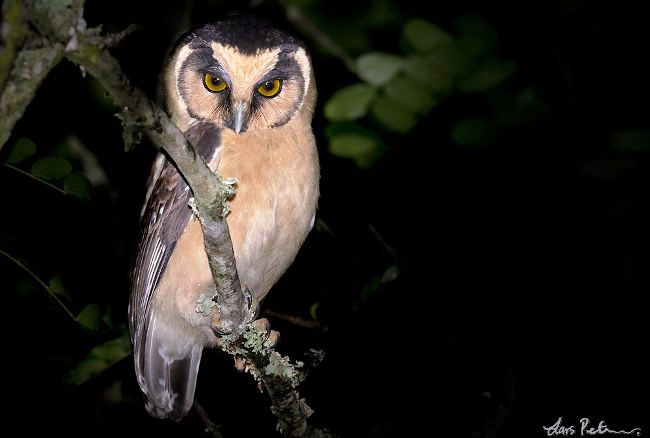
Once a mystery now possible to see, a rare image of a Buff-fronted Owl near Urcuqui by Lars Petersson, one of the four Aegolius owls in the world, the same genus as Boreal/Tengmalm's Owl.
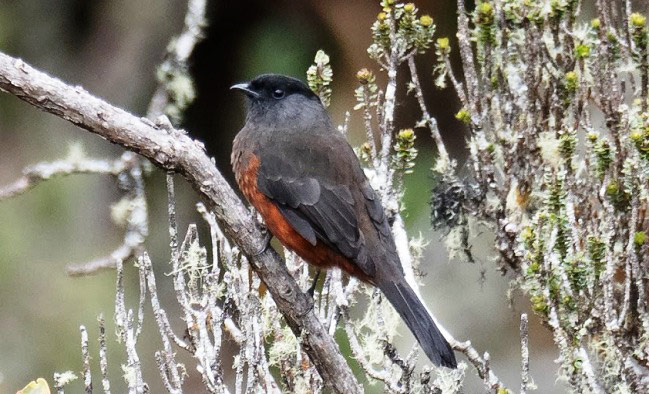
Chestnut-bellied Cotinga at Cerro Mongus by Simon Colenutt.
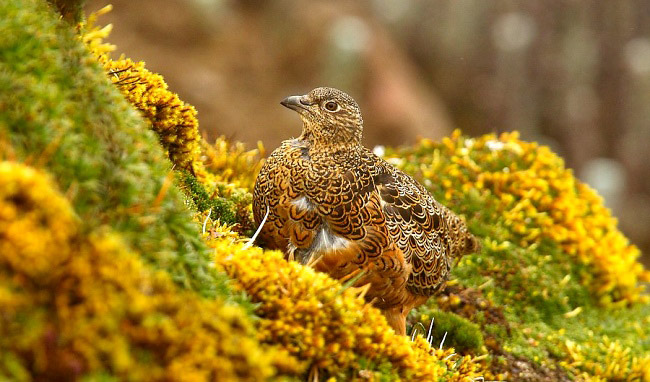
A Rufous-bellied Seedsnipe at Papallacta Pass by Francesco Veronesi.
Best Times for Birds and other wildlife in Northern Ecuador
The best time for birds is July to March, especially the second half of July and mid-September to mid-October for the Choco, and September-October for Amazonia. October is also the best time for orchids. Although wet all year round the Andes are usually drier between July and September, and Amazonia is usually drier between October and March.
Recommended Bird Books etc. for Northern Ecuador
Birds of Ecuador by J Freile and R Restall. Helm, 2018.
The Birds of Ecuador by R S Ridgely and P J Greenfield. Helm, 2001 (Two volumes).
Birds of South America: Non-Passerines by J R Roderiguez Mata et al. Harper Collins, 2006 hbk/Princeton University Press, 2006 pbk.
Birds of South America: Passerines by R S Ridgely and G Tudor. University of Texas Press/Helm, 2009 (Updated paperback edition of books listed next with 400 more illustrations).
The Birds of South America: Passerines by R S Ridgely and G Tudor. University of Texas Press, 1989 and 1994 (Two volumes).
Birds of Northern South America by R Restall, C Rodner and M Lentino. Helm, 2006 (Two volumes).
Birds of the High Andes by J Fjeldsa and N Krabbe. Zoological Museum, University of Copenhagen and Apollo Books, 1990.
Mammals of South America by R D Lord. Johns Hopkins University Press, 2007.
Wildlife of Ecuador: a Photographic Field Guide to Birds, Mammals, Reptiles and Amphibians by A Vasquez Noboa and P Cervantes Daza. Princeton University Press, 2017.
Traveller's Wildlife Guide: Ecuador and the Galapagos Islands by L Beletsky and D Pearson. Arris Books, 2010 (Second Edition).
Apps etc.
All Birds Ecuador by Sunbird Images (based on Birds of Northern South America (Helm, 2006), featuring 5000 illustrations and 3000 sound recordings for 1612 species). Available from iTunes store and Google Play.
Birds of Ecuador.
Hummingbirds of Ecuador.
Where to watch birds in South America by N Wheatley. Helm, 1994.
Don’t know which country/countries to visit in South America? Then it may be worth considering taking a look at this book, written by this website’s author. It is many years old of course but it still provides a starting point, an overview and a guiding light to the best birds and the best places to look for them on the continent, and could save hours of searching for similar information on the internet. However, it is important to check more up-to-date sources for sites which have been opened up, sites and species which have been discovered, lodges that have been built etc. since the book was published.
Birding and Wildlife Trip Reports for Northern Ecuador
Many trip reports, some for Northern Ecuador, are posted on the websites listed here. On some of these websites some reports are independent and some are posted by tour companies who organize tours to Northern Ecuador. These tour companies and others also post their own reports on their websites, which are listed under 'Some Organized Tours to Northern Ecuador' below.
Local bird and wildlife guides in Northern Ecuador
The costs of organized tours partly reflect the quality of the tour leaders. Some leaders are certainly better than others and many companies claim their leaders are the best but even the best rely at least to some extent on the exceptional skills of the local guides they employ. If you are travelling independently, employing such local guides will greatly increase your chances of seeing the wildlife you wish to see.
Accommodation for birders in Northern Ecuador
Some Organized Tours for birds and other wildlife to Northern Ecuador
There are many tour companies who organize tours to see mammals, birds, other wildlife and other natural wonders. The cost of these tours vary considerably according to such variables as the airlines used, the number of days the tours last, the number of sites visited, the number of people in the group (an important consideration if you wish to see such wildlife as rainforest mammals and birds), the number of tour leaders, the standard of accommodation and transport, and the percentage profit the company hopes to make. Generally, where the number of days tours last and the number of sites visited are similar, the cheapest tours are those that use the cheapest airlines, accommodation and local transport, that have the largest groups with the least number of leaders, and that make the least amount of profit. The most expensive tours tend to be those which are exceptionally long, use the most expensive accommodation (ridiculously lavish in some cases, even for single nights) and which make the most profit. Some tour costs partly reflect the quality of the tour leaders. Some leaders are certainly better than others and many companies claim their leaders are the best but even the best rely at least to some extent on the exceptional skills of the local guides they employ.
While tour companies organize tours with set itineraries many also organize custom tours for individuals and private groups who instead of taking a tour with a set itinerary want to follow their own itinerary to suit their own personal tastes, whether it be mammals, birds, other wildlife, other natural wonders or even man-made attractions, or a mixture of them all. Many organized tours with set itineraries are also fast-paced and target as many species as possible, whether they are mammals, birds or other wildlife or everything, which usually leaves little time to enjoy the best sites and individual species, but on a custom tour those taking part can specify the pace and the sites and species they wish to concentrate on. Custom tours also suit people who like to travel with people they already know, rather than with a group of strangers, and people with partners with different interests. Individuals and small groups will almost certainly have to pay more than the price of an organized tour with a set itinerary but a large group of friends may be able to travel for less than the price quoted for a set tour.
Tour companies who are running organized tours to Northern Ecuador in the next couple of years include the following. Many of these also offer custom tours.
